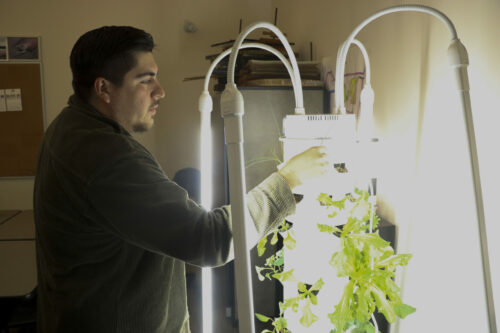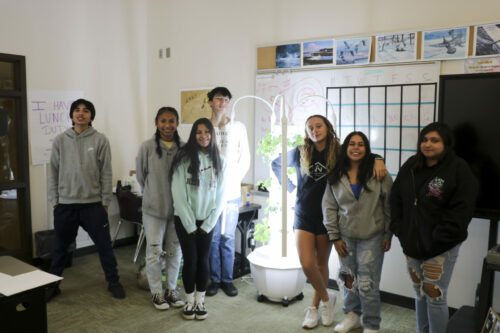By SCOTT MCKIE B.P.
One Feather Asst. Editor
CHEROKEE, N.C. – Plants are growing in a classroom at Cherokee High School (CHS) using a technique known as hydroponics. Students in Tagan Crowe’s Horticulture I class are learning the process first-hand and are growing a plethora of plants including the much sought after ramp – a traditional Cherokee plant.
The USDA defines hydroponics as “the technique of growing plants using a water-based nutrient solution rather than soil, and can include an aggregate substrate, or growing media, such as vermiculite, coconut coir, or perlite”.

Tagan Crowe, Cherokee High School agriculture teacher, shows a tower garden utilizing hydroponics in his Horticulture I class. (SCOTT MCKIE B.P./One Feather photos)
Crowe noted, “What I wanted was these tower gardens because they’re hydroponics. While I was at Oregon State, I did my senior thesis on hydroponics and how to grow traditional medicines and crops that we have.”
Students built several of the tower gardens in the classroom and are growing ramps, lettuce, Swiss chard, kale, broccoli, and arugula. Crowe said each tower costs around $800, and they were purchased through a grant from Harrah’s Cherokee to supplement the CTE (Career and Technical Education) programs at CHS.
While the students are excited about the entire project, growing ramps is of particular interest to them due to the cultural tie-in. Crowe said, “The reason we didn’t do a whole tower of ramps is because I don’t know how they’re going to grow just yet. Obviously, they’re looking really good. But ramps have a natural circadian rhythm…they do this over a long period of time. So, ramps go dormant around now and then they sleep for those few months. When people go to harvest them in January or February, they’re harvesting the first shoot of those ramps. What we’re going to be curious to see here is we’re simulating a perfect growing condition.”

Ramps are growing in one of the tower gardens.
“So, we’re trying to keep these ramps from going dormant and seeing if we can grow them on a full scale. I’m working on a grant right now with USET to grow nothing but traditional herbs and crops hydroponically. These ramps are the first stages of that grant to see if it’s possible first. It’s possible to get them to sprout and grow right now, but whether they go dormant or not is what we’re going to see within the next three to four months.”
Sara Toineeta, a student in the class, said, “It was really fun to make. It was really cool. We just filled up trash can buckets from the water fountains out there and poured them into the bottom. It’s really cool. They grew fast in those little things.”
“My mom does (gardens), but I don’t really. This is my first time. I expected it to take a lot longer for them to grow, but they grew fast.”
Marleigh Aguilera, a student, commented, “I feel like this works a lot better and easier. It’s just easier all-around than just planting outside.”
Crowe said the project has shown his students a different possibility for agriculture. “My goal is to just show the kids that you don’t have to have soil to grow plants. It’s a big misconception…or people really don’t know that you don’t have to have soil. Often times, it’s more healthy for the planet if you don’t use soil because you have soil degradation in conventional agriculture and industrial agriculture. They degrade the soil, and it takes years and years to get the soil back up to where it’s useful. Here all you need is water, and you can grow anything you need.”
“It shows the students that it doesn’t take hours and hours of work.”

Some of the students in Tagan Crowe’s Horticulture I class are shown, left to right, with one of their tower gardens including: Shown, left to right, are Ayden Lambert, Shelby Solis, Odie Codynah, Austin Anderson, Sara Toineeta, Marleigh Aguilera, and Abbygail Wildcatt.
He added, “In hydroponics, there’s no soil involved. We use the rock wool, and it uses up to 90 percent less water than conventional agriculture.”
“It takes a small footprint to grow tons and tons of vegetables. You don’t have to worry about soil…it uses way less water and they grow way, way fast.”
Austin Anderson, a student, noted, “I did not know that I could grow plants like that at all. We also learned to do container gardens. I actually formed my own container garden because of this class and because of this lesson right here.”
In his home container garden, Anderson grew yellow beans, kidney beans, radishes, tomatoes, and kale. “I’ve been doing it since I was little, but I’ve always wanted a class. I just moved here so I’ve wanted a class on gardening or just trees or nature in general.”
When asked if the project has inspired them to have such a garden at their own homes, the students all said yes.
Toineeta commented, “Yes. And, it’s more accessible for people who might have the ability to go outside and do gardens. If you’re older, stuff like that.”
Aguilera said, “I definitely would because I think it would be easier to keep up with because of the way it’s built, like Tagan said, there’s really not much maintenance in it. And, if it’s growing faster you don’t have to worry. And, with the lights on it, you can grow it inside. You don’t really have to go outside. You don’t have to worry about not having enough sun or it raining too much outside.”
She would also like to see this done tribal-wide. “I definitely would like to see the Tribe investing in hydroponics. Especially to grow more traditional crops and stuff like that, too. With ramps, if people were to go crazy and not be harvesting them correctly. I feel like it would be a really good investment.”





